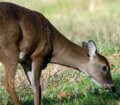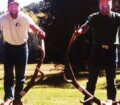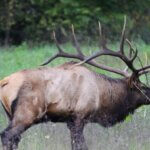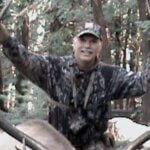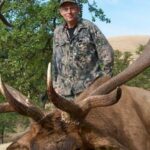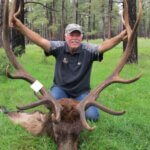Editor’s Note: Mark Hanson, from Mesa, Arizona, has a severe case of elk addiction. Mark took his first bull in 1984 with a bow—a spike with brow tines (a legal bull)—that really hooked him on elk hunting. Since then, he’s taken many bulls with his bow and two in Colorado with a rifle. However, he’s called in numerous bulls for friends and family members – about 100+ bulls. When Hanson isn’t hunting bull elk to take for himself, he hunts with friends and relatives yearly to help record their hunts, finds bulls for them, calls bull elk, and carries out the meat.

I primarily hunt elk in eastern Arizona, near the New Mexico border, south of Alpine, Arizona, just outside the Apache-Sitgreaves National Forest. In the past, drawing an elk tag was much easier than it is today. Almost all the elk hunts in Arizona are drawn hunts. (You go into a lottery, and if your application is drawn, you get a tag to take an elk). There are a few over-the-counter tags available in certain areas. When I’m asked what I like so much about elk hunting, I answer that I like being able to call the elk to me and get inside their heads. Elk hunting is a lot like turkey hunting. You can get a lot of interaction with a bull elk, even if you don’t harvest him.
The public land I hunt isn’t far from the White Mountain Apache Reservation, and when the rut kicks in, some of those huge bulls will begin moving off the reservation. When I first started hunting elk in Arizona and New Mexico, drawing a tag wasn’t difficult at all. I drew a New Mexico tag four out of five years to bow hunt on their public elk units. But today, you may not draw an out-of-state archery elk tag for 5-8 years. Too, the cost of an out-of-state non-resident license has been raised. Additionally, in New Mexico, the ranchers have a lot of input on the elk-season regulations. Although in Arizona, there’s not nearly as much private land as in New Mexico, today, I primarily hunt in Arizona and have more fun and success than I ever did in New Mexico.
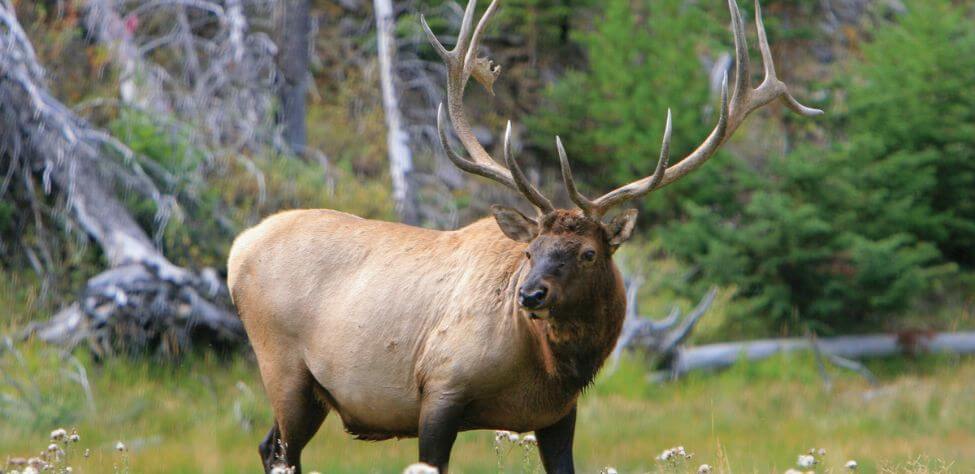
The first year – early 1990s – that I hunted this region, I drew a tag. In fact, I drew tags to hunt this area four out of five times in the early 1990s. A good elk-hunting friend of mine, Randy Ulmer, had recommended I hunt this area. I’d hunted in places across the border in New Mexico that were adjacent to this region. Also, I had a tag for New Mexico. Since the Arizona unit butted up against the one in New Mexico where I had permission to hunt, that tag gave me access to much more land to hunt in whichever state. If I saw a bull I wanted to take, I could harvest him. For a newcomer, these two areas, with several steep canyons and high ridges, can be really tough to hunt. I did some scouting before I hunted this property. I went in and found a campsite, and I chose to hunt in a wilderness place where the only access was on foot. I first started hunting in New Mexico. However, I didn’t have much success for the first three or four days of my hunt, so I decided to move my camp over to the public lands in Arizona. I hunted for two weekends on the Arizona unit, and finally, on the second weekend, I had a 5×5 elk that chose to commit suicide.
I scouted the site and found some well-worn elk trails. Some logging was being done outside the wilderness areas where I was hunting. When there’s logging going on in elk country, the sounds of chainsaws and falling timber become dinner bells for elk. When loggers open up the forest canopy, and sunshine can hit the ground, native grasses and shrubs will start to appear, which the elk love to eat. If an aspen tree falls to the loggers, the elk will eat the aspen bark and leaves. I’ve learned over the years, that a timber harvest draws in elk almost as well as water holes do. The trails I decided to hunt were trails that went out into the clear-cuts and back into the wilderness area.
I was hunting on a Sunday, this second week of a two-week hunt. Even though I could hunt four more days afterward with my tags, I had to be at my job on Monday morning. Once I got set up, I started cow-calling. Then I heard a bullbugle back to my calls. Immediately I got off the trail I was watching and set up about 10 yards off.
The first time I saw the bull, he was only 30 yards away. I was hunting with a Proline bow back then, and on my arrow shaft, I had a 100-grain Thunderhead broadhead. The bull walked right past me. I came to full draw and released the arrow when the bull was only 10 yards. I aimed behind his shoulder and shot the bull while he was walking. When I have an elk that close, I don’t try to stop him with a call. I had a clean pass-through when the arrow went through the bull, and as I watched, he ran about 40 yards, turned to run up to the top of the canyon, and then fell. This bull was not a monster and wouldn’t have scored more than 280 inches. But this bull was the first I’d taken from this unit. Back in those days, I didn’t really know a lot about how to get a bull back to the truck.
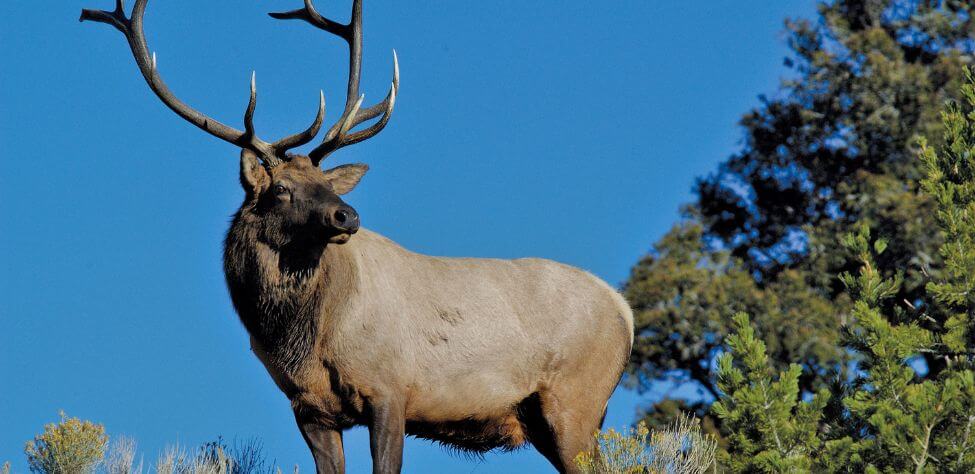
The bull had gone down at 10:00 a.m., and I didn’t get all the meat out until midnight. Luckily, my bull fell near the top of a ridge, so I hiked back to my truck to pick up my Camp Trails Freighter Frame Pack, knives, a small saw, a small block-and-tackle, and a rope. I used the block-and-tackle to pull the elk off the ground to field dress the elk. Then I let him down and used the block-and-tackle to help pull one leg out to skin him. I carried the four quarters, the backstraps, and the tenderloins, and put them in with one of the front shoulders I was packing. All of this took about four trips to my truck. Then, on the fifth trip, I carried the head out. When I returned to camp, I slept a few hours, got up, and headed home on Monday morning. I called and told my boss, “I took an elk, so I’m going to be a little late to work.” I dropped off the meat at a processing plant, and then I went to work for the rest of the day.”
I learned from this hunt what elk hunting was all about. Today, I don’t carry the quarters out generally, unless I’m really close to the truck. With that first 5×5, my truck was 1-1/2 miles away. When I made the first trip to my truck to get all my butchering gear and walked back 1-1/2 miles to where the elk was down, that was three miles. Then, I made five trips to get the meat and returned to the truck. That day, I hiked 15 miles after the elk was down. For five of those 15 miles, I walked with quarters of elk and meat on my back.
From that elk hunt, I learned:
- Having a buddy means you’ve got someone to help you field dress and quarter your animal;
- Taking a buddy with you on an elk-hunting trip reduces the trips you have to make to your vehicle with meat;
- Getting back to camp earlier when you have help is far better than trying to do it all on your own, and
- Going with my friends and family and helping them on their elk hunts is something I’ve learned to do because I understand what spending most of the day field dressing and quartering an elk and a good portion of the night carrying meat out of the high country is like.
Expert Guidebooks on Elk Hunting: Best Sellers

Secrets for Hunting Elk
The quickest, easiest (if there is an easy way), and safest way to find and take that bull elk of a lifetime will be to hunt with a guide.
Chad Schearer, a longtime Montana guide and TV personality, told me, “My hunter is my gun. If I get to the elk, and my hunter isn’t with me, then we don’t take the elk. My job is not only to find the elk but also to help the hunter get to the elk and make the experience as enjoyable as I can for him.” That’s the kind of fella with whom I want to go elk hunting.
An elk hunt can be tough, but it doesn’t have to be so tough that you don’t enjoy it. That’s why this elk hunting book starts with the confessions of an elk guide and with Chad Schearer’s philosophy of what the guide and the hunter’s relationship should be.
A good portion of your success will depend on your physical condition, and Matt Morrett of Harrisburg, Pennsylvania explains how an eastern hunter can get ready physically during June and July to hunt western elk, the animals he describes as, “Like deer or turkeys on steroids.”
Wayne Carlton, well-known elk hunter and TV and video personality from Montrose, Colorado, tells us what types of elk calls to use and what to say to the elk. Mike Miller of Colorado, another elk guide and Mossy Oak video personality, has tactics for the best equipment for bowhunting and gun hunting elk.
You’ll learn helpful strategies and hunting tips in this book, as well as some straightforward hunting methods that will help to make your elk hunt more successful.
“Thanks to the advice in your elk hunting books, I was able to call up a nice 6-point (6X6) bull elk! He was bugling like crazy. I called him in from about a ¼ mile away. Called him into bow range (about 40 yards away). It was a thrill!” ~Rob Brannon
VERSIONS: AUDIBLE & KINDLE

Elk: Keys to 25 Hunters’ Success
Often just one tip or tactic makes the difference in whether you take an elk home to dinner or have to hike back to the truck by yourself. In John E. Phillips’ latest elk book, Elk: Keys to 25 Hunters’ Success, you’ll learn from successful elk hunters the strategies they use to find and take elk.
Many know that the technique that seems to work most often is to hunt where other elk hunters don’t and understand where the elk are before you go on a hunt by studying data from each state, visiting HuntData (see chapter 1), examining maps, and reading postings on elk forums.
This book also tells you how to get ready physically for an elk hunt, including participating in Train to Hunt Competitions, what gear you need to take, how to enjoy a successful do-it-yourself elk hunt, or how to pick the best elk guide for you. You’ll also hear about the X System and the Broken Y System of hunting elk.
Although no one person has all the answers on how to help you find and take your elk, I’m convinced that this book’s outdoors men and women will teach you how to have satisfying elk hunts.
As my friend Karl Badger once told me, “Elk hunting doesn’t get any better than when I ride horses into the high backcountry, see two grizzly bears, hear a pack of wolves howl close to camp all night long, eat plenty of delicious food prepared on a fire and enjoy the company of good friends.”
VERSIONS: AUDIBLE, KINDLE & PRINT

How to Find Your Elk and Get Him in Close will teach you the tactics of 10 nationally known elk hunters, to help put that giant bull that’s been screaming at you from afar, in your lap. You’ll learn what some of the best guides, outfitters, and successful elk hunters do to find elk and get them in really close.
Also in this audiobook, you’ll notice that the majority of the experts call elk to within bow range. We selected numerous bowhunters and bowhunting guides, since the bowhunter has to get much closer to a bull than the gun hunter does – often less than 20 or 30 yards – practically in your lap.
On one elk hunt, I’d heard this bull bugle all morning. My guide had called him within 30 yards, and he was standing just inside black timber. I saw the smoke from his nose wafting out into the icy air less than 30-yards away. All the bull had to do was step out, and I could take the shot with my bow. But then, through no fault of my guide or me, the bull vanished.
The only conclusion I could come up with to understand why the bull I wanted to take with my bow hadn’t stepped out and given me a shot, was because he got raptured. He evidently had left the earth with no trace of himself.
This hunt was when I started wanting to learn more about hunting elk up close. In this book, I’ve tried to find some of the most knowledgeable, experienced, and practical elk hunters. I’ve always found that the best way to learn any outdoor skill, is to either hunt or fish with the best sportsmen in that field.
Often, in elk hunting, that means elk guides, who generally hunt every day of the season and receive a salary for every hunter they guide. So, I’ve put together a group of some of the best elk hunters I know to help us all learn how to find bull elk and get them in close.
VERSIONS: AUDIBLE, KINDLE & PRINT
Tomorrow: Shooting a Big Bow Bull Elk

